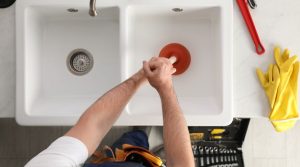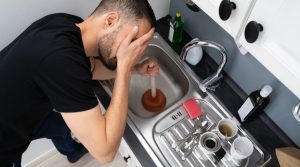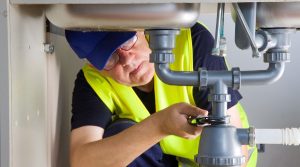Did you know that heating your water takes up almost 20% of your home’s energy bill? Almost every other household task uses less energy than heating water (except for heating and cooling your whole home.) With costs that high, if your water heater isn’t very efficient, you’ll feel it even more.
Water heaters that aren’t very efficient don’t work as well as they should and cost more each month. It’s a situation where everyone loses, and it might get worse over time. There are a few tried and true ways to improve the efficiency of your water heater. Here are five simple projects that will help your water heater work better and save you money.
Step 1: Drain Water Heater Sediment
Minerals like magnesium and calcium build up in the tank of your water heater over time. These minerals will eventually sink to the bottom of the tank, where they will harden and form sediment. When sediment builds up in your tank, it can make your water heating system work harder than it needs to. Over time, the extra work causes pressure to build up inside the tank, which can cause it to overheat or even break. You can easily get rid of the sediment in your water heater by draining it completely and flushing it out with cold water at least once a year (or up to three times if you have hard water).
Getting rid of sediments will make your heater work much better and prevent more expensive repairs that can happen when sediments build up. Flushing your water heater is a simple project that you can do yourself if you have the right tools. You can also hire someone to do it as part of a larger maintenance call for your water heater.
Step 2: Insulate Water Pipes
Especially in your pipes and water tank, heat tends to escape quickly. Even though this is normal, it makes your water heater less effective than it could be. When heat is lost in your pipes, you have to heat more water to make up for it. The longer and harder your water heater runs and the more electricity it uses, the more water you heat. This means your electric bill will be higher. Insulating water pipes keep heat from escaping and make them work better.
When you insulate your pipes, the heat stays where it belongs in the system. Insulated water pipes keep heat in for longer and can even raise the temperature of the water by 2 to 4°F on their own. Even wrapping your cold water pipes in insulation can help.
If you do a little research, it’s not hard to insulate your pipes and water heater. Just choose an insulation material, measure your pipes, and get started with things you already have at home, like scissors, a tape measure, duct tape, and gloves.
Step 3: Use low-flow fittings
Low-flow plumbing fixtures are another easy way to save money in the long run without putting in a lot of time or work front. Low-flow fixtures do what their name says: they slow the rate of water flow (in gallons per minute) so that less of your valuable hot water goes down the drain unnecessarily.
Consider replacing things like shower heads, faucets, and even toilets with ones that use less water. This will save the most energy because it will cut water use by up to 50 percent. They cost a bit more upfront, but in the long run, they save you a lot of money. This is especially true if someone in your home is known for taking long, hot showers.
Step 4: Set your Water Heater to 120 Degrees Fahrenheit
Many people don’t know this, but every water heater has a thermostat built right in. This thermostat tells the system how much heat to put into the tank to heat the water. The longer your system runs and the more energy it uses, the hotter the water it heats. Check your water heater’s thermostat setting if your hot water gets very hot quickly or seems dangerously hot. Your water will be safer and your bills will be lower if you turn down your water’s thermostat.
Most manufacturers will set a water heater’s default temperature to 140 degrees. In reality, you shouldn’t wash or bathe in water that is hotter than 120 degrees anyway. Even though experts agree that bacteria can grow in settled tank water at temperatures below 120 degrees, don’t set your water heater temperature any lower than that. You can save 3-5% a year on your water bill by following the steps in this guide to manually lower the temperature on your water heater at home.
Step 5: Fix any leaks in the plumbing
Leaks in plumbing happen more often than you might think. They also affect your house in more ways than you might think. Even small faucet leaks waste 1,661 gallons of water and $35 on your water bill per year. Your water heater is also affected by all that wasted water. When hot water leaks out of your pipes, your water heater has to work harder. That means it is running longer and, of course, using more energy. The most common sign of a plumbing leak is a water heater that runs all the time to make up for lost hot water. So how do you know if you have a leak before it drains your water tank and your wallet?
Most leaks in your water heater start inside the heater itself. Start by looking for leaks around the tank of your water heater. The most likely sources are the temperature-pressure relief valve and the drain valve. The temperature-pressure relief valve might leak because it’s broken or because it’s supposed to. You should also check the water pipes, especially where they connect to sinks, showers, and other fixtures. Keep in mind that no leak is “too small” to fix. Call your local plumber if you need help fixing or finding possible plumbing leaks.
Maintain your water heater on a regular basis
When your water heater seems to be working fine, it’s easy to forget about it. Even if there are no obvious leaks or problems, you should make sure your heater is as efficient and well-maintained as it can be. It will save you money on your water bill now, and it will also help your water heater last longer.
If you need help making sure your water heater works as it should, or if you want to replace or fix your water heater, call the plumbing experts at CBJ Passaic Plumbers today to schedule a service. We’re always happy to do whatever we can to make you feel comfortable in your home and save you money in the long run.





